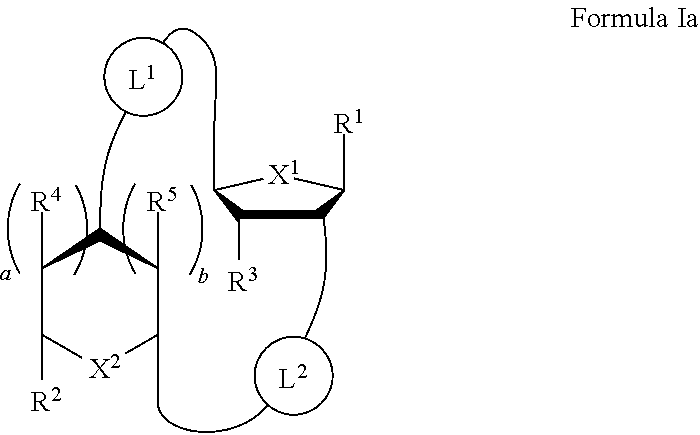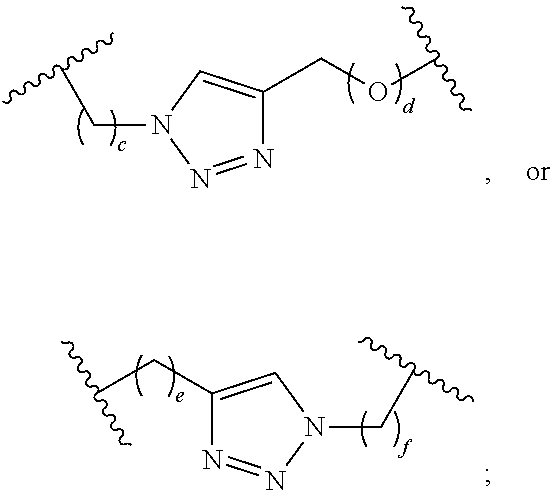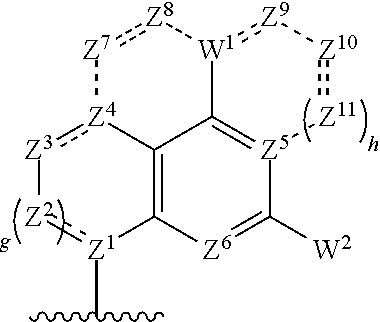Cyclic di-nucleotide compounds and methods of use
a technology of cyclic dinucleotide and compound, applied in the field of new cyclic dinucleotide cgamp analogs, to achieve the effect of improving cellular uptake, stability and efficacy
- Summary
- Abstract
- Description
- Claims
- Application Information
AI Technical Summary
Benefits of technology
Problems solved by technology
Method used
Image
Examples
example a
of E5
[0588]
Step 1: C4
[0589]
[0590]To a solution of A4 (1.0 g, 1.01 mmol) and G1 (1.07 g, 2.02 mmol) in MeCN (10 mL) is added Py.DCA (420 mg, 2.02 mmol). After stirring at 20° C. for 2 hours, TBHP (70% in water, 0.65 mL, 5.05 mmol) is added and the mixture is stirred for 1 hour before sodium bicarbonate aqueous solution (50 mL) is added. The mixture is extracted with ethyl acetate (100 mL) and the organic layer is washed with brine (30 mL), dried with anhydrous sodium sulfate, filtered, and concentrated. The residue is then dissolved in a mixture of DCM (20 mL), TFA (1.0 mL) and triethylsilane (5.0 mL). After stirring for 2 hours, the mixture is neutralized with solid sodium bicarbonate to ˜pH 7. The mixture is then filtered and the solid is washed with EA (50 mL×3). The filtrate is concentrate and purified by preparative HPLC (MeCN with 0.1% TEA / water=0% to 30%) to give C4.TEA as a white solid (620 mg, 49% yield). (MS: [M+H]+ 1131.1)
Step 2: Phosphodiester 83
[0591]
[0592]To a solution ...
example b
of E15-E18
[0597]
Step 1: C5
[0598]
[0599]To a mixture of A4 (500 mg, 0.50 mmol, co-evaporated with MeCN 5 mL×1 and toluene 10 mL×2) and G1 (322 mg, 0.61 mmol, co-evaporated with MeCN 5 mL×1 and toluene 10 mL×2) is added tetrazole (0.45 M in MeCN, 4.0 mL). After stirring at 25° C. for 2 hours, DDTT (240 mg, 1.2 mmol) is added and the mixture is stirred for 16 hour before filtered and concentrated. The residue is then dissolved in DCM (10 mL) followed by addition of water (0.1 mL) and DCA (0.21 mL). After stirring for 10 minutes, TEA (1 mL) is added and the mixture is concentrate and purified by reverse-phase silica gel column chromatography (MeCN with 0.1% TEA / water=0% to 100%) to give C5.TEA as a white solid (250 mg, 35% yield). (MS: {[M+2H]2+) / 2 574.6)
Step 2: Phosphorothioate 85
[0600]
[0601]To a solution of C5 (600 mg, 0.423 mmol, co-evaporated with Py 3 mL×2) in Py (5.0 mL) is added DMOCP (313 mg, 1.69 mmol) at 25° C. After stirring for 2 hours, 3H-1,2-benzodithiol-3-one (142 mg, 0.85...
example c
of E24
[0604]
Step 1: Phosphoramidate 44
[0605]
[0606]To a solution of C3 (16 mg, 0.014 mmol, co-evaporation with Py 1 mL×3) in Py (0.5 mL) is added DMOCP (10.4 mg, 0.056 mmol). After stirring for 15 minutes, NIS (4.1 mg, 0.0183 mmol) and morpholine (0.012 mL, 0.141 mmol) are added and the mixture is stirred for 1 hour before sodium bisulfite aqueous solution (0.14%, 1 mL) and sodium bicarbonate (80 mg) is added. The mixture is then extracted with DCM (5 mL×3), dried over anhydrous sodium sulfate, and concentrated. The residue is then stirred in MeCN (0.5 mL) and t-butylamine (0.5 mL) at room temperature for 15 minutes before concentrated. The resulting residue is then co-evaporated with MeCN (1 mL×3) and purified by HPLC to give 86 as a white solid (2.4 mg, 15%). (MS: [M+H]+ 1146.2)
Step 2: E24
[0607]
[0608]To 86 (2.4 mg, 0.0021 mmol) is added methylamine (33% in EtOH, 0.3 mL). After stirring at room temperature for 16 hours, the mixture is concentration and the residue is stirred in a mi...
PUM
| Property | Measurement | Unit |
|---|---|---|
| pH | aaaaa | aaaaa |
| temperature | aaaaa | aaaaa |
| temperature | aaaaa | aaaaa |
Abstract
Description
Claims
Application Information
 Login to View More
Login to View More - R&D
- Intellectual Property
- Life Sciences
- Materials
- Tech Scout
- Unparalleled Data Quality
- Higher Quality Content
- 60% Fewer Hallucinations
Browse by: Latest US Patents, China's latest patents, Technical Efficacy Thesaurus, Application Domain, Technology Topic, Popular Technical Reports.
© 2025 PatSnap. All rights reserved.Legal|Privacy policy|Modern Slavery Act Transparency Statement|Sitemap|About US| Contact US: help@patsnap.com



